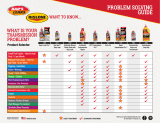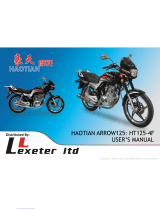ENGLISH
5
TABLE OF CONTENTS
»
Page
SERIAL NUMBER LOCATIONS . . . . . . . . . . . . . . . . . . . .6
Chassis number . . . . . . . . . . . . . . . . . . . . . . . . . . . .6
Engine number . . . . . . . . . . . . . . . . . . . . . . . . . . . . .6
OPERATION INSTRUMENTS . . . . . . . . . . . . . . . . . . . . . .6
Clutch lever . . . . . . . . . . . . . . . . . . . . . . . . . . . . . . . .6
Hand brake lever . . . . . . . . . . . . . . . . . . . . . . . . . . . .6
Short circuit button . . . . . . . . . . . . . . . . . . . . . . . . . .7
Filler cap . . . . . . . . . . . . . . . . . . . . . . . . . . . . . . . . .7
Fuel tap . . . . . . . . . . . . . . . . . . . . . . . . . . . . . . . . . .7
Choke . . . . . . . . . . . . . . . . . . . . . . . . . . . . . . . . . . .7
Shift lever . . . . . . . . . . . . . . . . . . . . . . . . . . . . . . . .7
Kickstarter . . . . . . . . . . . . . . . . . . . . . . . . . . . . . . . .8
Foot brake pedal . . . . . . . . . . . . . . . . . . . . . . . . . . . .8
Compression damping of shock absorber . . . . . . . . . . .8
Rebound damping function of the shock absorber . . . .8
Plugin-Stand . . . . . . . . . . . . . . . . . . . . . . . . . . . . . .8
GENERAL TIPS AND WARNINGS FOR STARTING
THE MOTORCYCLE . . . . . . . . . . . . . . . . . . . . . . . . . . .10
Instructions for the first ride . . . . . . . . . . . . . . . . . .10
Running in . . . . . . . . . . . . . . . . . . . . . . . . . . . . . . .10
DRIVING INSTRUCTIONS . . . . . . . . . . . . . . . . . . . . . . .11
What you should check before each start . . . . . . . . .11
Starting when the engine is cold . . . . . . . . . . . . . . .12
Starting when the engine is warm . . . . . . . . . . . . . . .12
What to do when the engine is „flooded“ . . . . . . . . .12
Starting off . . . . . . . . . . . . . . . . . . . . . . . . . . . . . . .12
Shifting/Riding . . . . . . . . . . . . . . . . . . . . . . . . . . . .12
Braking . . . . . . . . . . . . . . . . . . . . . . . . . . . . . . . . .13
Stopping . . . . . . . . . . . . . . . . . . . . . . . . . . . . . . . .13
Refueling, fuel . . . . . . . . . . . . . . . . . . . . . . . . . . . .13
PERIODIC MAINTENANCE SCHEDULE . . . . . . . . . . . . .14
MAINTENANCE WORK ON CHASSIS AND ENGINE . . . .16
Checking and adjusting the steering head bearing . . .16
Breather plug front fork . . . . . . . . . . . . . . . . . . . . . .16
Cleaning the dust sleeves of the telescopic fork . . . . .17
How to change the handlebar position . . . . . . . . . . .17
Changing spring preloading of the shock absorber . . .17
Basic suspension setup for the weight of the driver . .18
To determine the sag of the shock absorber . . . . . . . .18
To determine the sag of the telescopic fork . . . . . . . .18
Page
Checking chain tension . . . . . . . . . . . . . . . . . . . . . .19
Correcting chain tension . . . . . . . . . . . . . . . . . . . . .19
Chain maintenance . . . . . . . . . . . . . . . . . . . . . . . . .19
General information about KTM disc brakes . . . . . . .20
Adjusting the free travel at the hand brake lever . . . .20
Checking/refilling the front brake fluid level . . . . . . . .21
Checking front brake pads . . . . . . . . . . . . . . . . . . . .21
Replacing the front brake pads . . . . . . . . . . . . . . . . .22
Changing basic position of the brake pedal . . . . . . . . .22
Checking the rear brake fluid level . . . . . . . . . . . . . .23
Refilling the rear brake fluid reservoir . . . . . . . . . . . .23
Checking rear brake pads . . . . . . . . . . . . . . . . . . . . .23
Replacing the rear brake pads . . . . . . . . . . . . . . . . .24
Removing and installing front wheel . . . . . . . . . . . . .24
Removing and installing the rear wheel . . . . . . . . . . .25
Tires, air pressure . . . . . . . . . . . . . . . . . . . . . . . . . .25
Checking spoke tension . . . . . . . . . . . . . . . . . . . . . .25
Removing the seat . . . . . . . . . . . . . . . . . . . . . . . . .26
Cleaning the air filter . . . . . . . . . . . . . . . . . . . . . . . .26
Exhaust system . . . . . . . . . . . . . . . . . . . . . . . . . . . .27
Checking the oil level of the hydraulic clutch . . . . . .27
Bleeding of the hydraulic clutch . . . . . . . . . . . . . . . .27
Changing the original position of the clutch lever . . . .28
Cooling system . . . . . . . . . . . . . . . . . . . . . . . . . . . .28
Checking coolant level . . . . . . . . . . . . . . . . . . . . . . .28
Adjusting the throttle cable . . . . . . . . . . . . . . . . . . . .28
Carburetor adjustment . . . . . . . . . . . . . . . . . . . . . . .29
Draining the float chamber of the carburetor . . . . . . .30
Checking gear oil level . . . . . . . . . . . . . . . . . . . . . . .30
Changing gear oil . . . . . . . . . . . . . . . . . . . . . . . . . . .30
TROUBLE SHOOTING . . . . . . . . . . . . . . . . . . . . . . . . .31
CLEANING . . . . . . . . . . . . . . . . . . . . . . . . . . . . . . . . .33
STORAGE . . . . . . . . . . . . . . . . . . . . . . . . . . . . . . . . . .33
USE AFTER PERIOD OF STORAGE . . . . . . . . . . . . . . . .33
TECHNICAL SPECIFICATIONS – CHASSIS . . . . . . . . . . .34
TECHNICAL SPECIFICATIONS – ENGINE . . . . . . . . . . . .35
INDEX . . . . . . . . . . . . . . . . . . . . . . . . . . . . . . . . . . . . .37






















